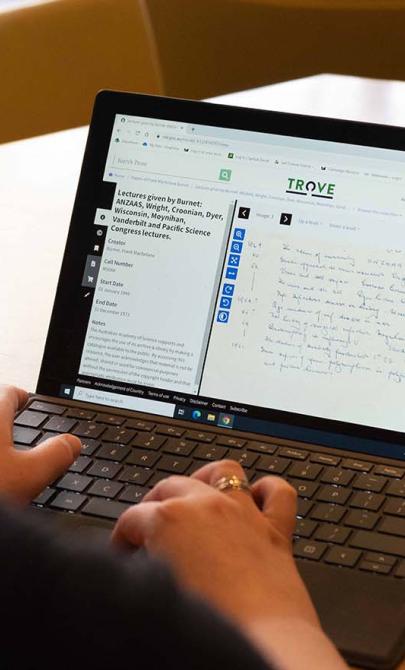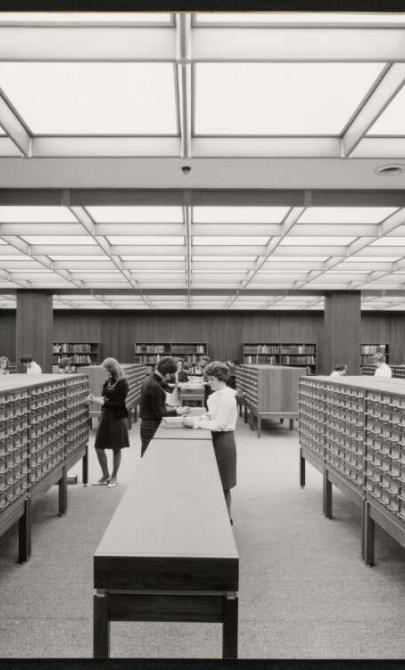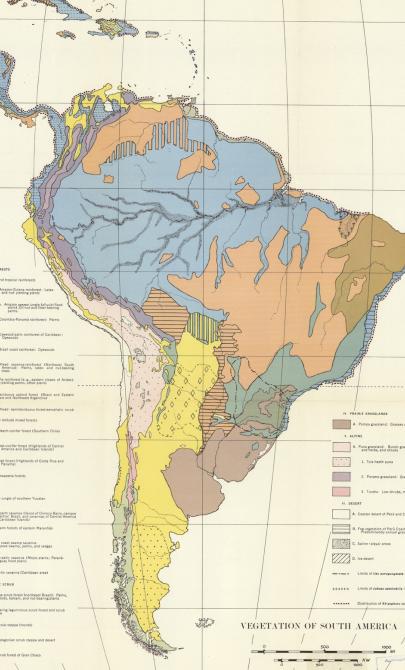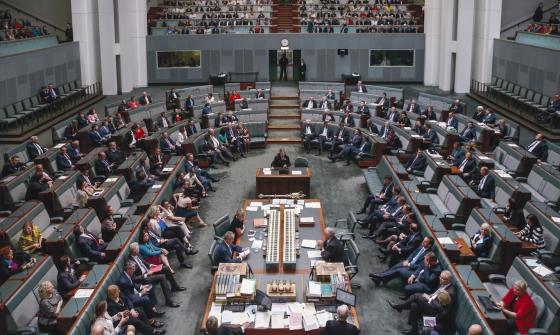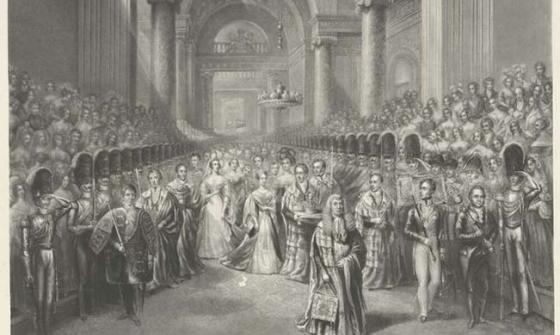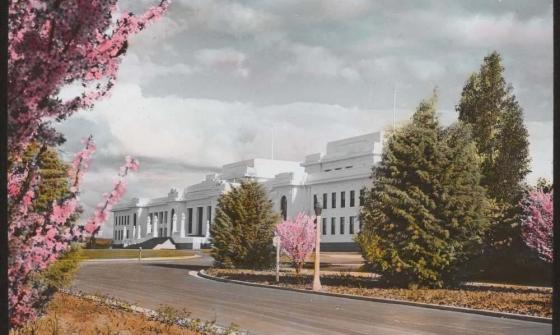United States Congressional publications and information
Background to the Library collection
The Library received, on deposit, United States Government Printing Office (USGPO) microfiche from 1983 to 2010. It is arranged by Superintendent of Documents classification, given at the top of each fiche, and is known as SUDOC. This SUDOC numbering is based on the structure of government agencies, which can make it quite complex.
You can find information about how to interpret SUDOC numbers from the West Texas A & M University website.
The Library ceased receiving SUDOC fiche in June 2010, but the existing collection is retained. This guide provides information on how to access this large collection, as well as other United States Congressional publications held in the Library and online.
American material in the library collection
Extract from Burmester, National Library of Australia : guide to the collections
The close association of the United States and Australia during the War was such that when President Franklin Delano Roosevelt died on 12 April 1945, Prime Minister Curtin announced that Australia would honour his memory and that association by establishing a special collection of American material in the Commonwealth National Library. The objective of the collection, stated the Prime Minister, was to document the rise and development of the American civilization in all its aspects, to an extent that would encourage understanding of the United States, its problems and its achievements.
Such an objective could not be achieved overnight but, as a result of slow, sometimes laboriously systematic, effort and at considerable cost, the collection which has been gathered over a period of thirty-five years is already recognised as one of the strongest assemblies of Americana outside the United States itself. Its strength was demonstrated by the Library's publication in 1976 of its 106 page America on Record: a guide to works and other materials relating to the United States of America in the National Library of Australia to mark the Bicentenary of American Independence.
News and print resources on Congress
- CQ Weekly (Congressional quarterly weekly). Each year these issues have been consolidated to produce the CQ Almanac Plus and the CQ Almanac.
- Congress.gov
- Official Congressional Directory from 1888. Also available online.
Selected print resources
- Subject guide to U.S. government reference sources by Gayle J. Hardy and Judith Schiek Robinson (1996)
- Monthly catalog of United States government publications (1985-2000) Also available online.
- Introduction to United States government information sources by Joe Morehead (1996)
America's historical imprints
America's Historical Imprints consists of two searchable databases of monographs, pamphlets, broadsides, government documents and ephemera.
- Early American Imprints. Series 1, Evans (1639-1800) covering the colonial period
- Early American Imprints. Series II, Shaw-Shoemaker (1801-1819) covering the early decades of the United States
These databases are only available inside the Library building in Canberra. Visit our eResources portal onsite and search for each resource under the Browse eResources tab.
Online information
- The U.S. Embassy & Consulates in Australia provides online information about the US government and resources for school students and teachers.
- The Library of Congress has produced a comprehensive online guide to the U.S. Congress.
- The GovInfo website produced by the U.S. Government Publishing Office provides links to Congressional publications.
- The Center for Legislative Archives has a number of useful finding aids for conducting research in the records of Congress.
- E. Malone, C. (2014), "Entry points for government information: a comparative look at four sources", Reference Reviews, Vol. 28 No. 2, pp. 2-6 - A comparison of four free government resources, this open-access article is aimed at librarians and library users.
Also see: GovTrack.us
Case study
I would like to know about the National Library's status as a depository library for the U.S. Government publications. Does the Library get all publications coming from the Government Printing Office and does this go back to 1969-1970?
If these periodicals are available, can they be interlibrary loaned to Sydney?
The National Library received (as part of its long standing Gift and Exchange arrangement with the United States) copies of U.S Government Publications (known as SUDOC). Originally supplied in print, since the early 1980s most of these publications have been received in microfiche. The arrangement ceased in 2010.
You can browse the Library Catalogue, for example using '91st Congress' as keywords, to find the items you need. Each document from the 91st Congress has an individual title. Many documents are available online; if this is the case, there will be a link in the online record. For example, see Select Committee on Equal Educational Opportunity, United States Senate, 91st Congress, 2nd Session, September 1970.
The SUDOC microfiche collection is available for interlibrary loan. Please contact your local library for further help with interlibrary loans.
Congressional resources
The proceedings of Congress are recorded in the Journals of Congress. The Journals note the matters considered by the House and the Senate, and include votes and other actions taken.
Library holdings and online access
| Time Period | Format and links |
|---|---|
| 1789 - 1875 | Online from the Library of Congress |
1817-1952 The House Journal is included in the Congressional Document Set. See Documents and reports to Congress below for information on how to verify and locate these publications | Paper Consult the CIS US Serial Set Index - 1789 to 1969 |
| 1875-1983 (imperfect) | Controlled Access Collection |
| 1979 - 2010 | Microfiche |
| 1818 - 2021 | Online from the US Government Publishing Office |
| Time Period | Format and links |
|---|---|
| 1789 - 1875 | Online from the Library of Congress |
1817 - 1952 The Senate Journal is included in the Congressional Document Set. See Documents and reports to Congress below for information on how to verify and locate these publications. | Paper Consult the CIS US Serial Set Index - 1789 to 1969 |
| 1873 - 1986 (imperfect) |
held offsite |
| 1979 - 2010 | Microfiche |
| 1818 - 2022 | Online from the US Government Publishing Office |
| Time Period | Format and links |
|---|---|
| 1789 - 1875 | Online from the Library of Congress |
| 1805 - 2007 (imperfect) |
Controlled Access Collection |
| 1967 – 2010 | Microfiche |
Background
From The United States Constitution, Article I, section 5:
'Each House shall keep a journal of its proceedings, and from time to time publish the same, excepting such parts as may in their judgment require secrecy; and the yeas and nays of the members of either House on any question shall, at the desire of one fifth of those present, be entered on the journal.'
More information about the journals can be found in the Library of Congress online guide.
SUDOC
You might notice the acronym SUDOC in the call numbers of the United States Government microfiche Catalogue records.
United States Government Printing Office (USGPO) microfiche was received on deposit from 1983. It is arranged by Superintendent of Documents classification, given at the top of each fiche. Collect fiche from the Newspaper & Microforms Reading Room.
You can find information about SUDOC numbers from the West Texas A & M University.
The National Library ceased receiving SUDOC fiche from June 2010, but the existing collection is retained.
A bill or resolution is introduced by a member and generally referred to a Congressional committee as part of its passage to approval. The first printing of a bill or resolution includes:
- the number and session of the Congress
- the designation
- the number of the bill
- the name of the body in which it was introduced
- date of introduction
- the name of the member who introduced it
- the Committee to which it was referred.
Library holdings and online access
| Time Period | Format and links |
|---|---|
House and Senate Bills 1789 -1879 Includes the bills, resolutions, joint resolutions and concurrent resolutions of the House and Senate | Microfilm |
Bills and Resolutions House: 1700-1873 Senate: 1819-1873 Senate Joint Resolutions: 1824-1873 | Online from the Library of Congress |
Digest of Public General Bills and Resolutions 1936-1987 Provides summaries of bills only | 1936-1970 held offsite 1970-1987 in Controlled Access Collection |
House and Senate Bills 1961 -1965 | Microcard |
Bills 1982 – 2010 House Senate | Microfiche |
House and Senate Bills 1993 to date | Online from the US Government Publishing Office |
Joint Resolutions House Joint Resolutions: 1982-2010 Senate Joint Resolutions: 1982-2010 | Microfiche |
Concurrent Resolutions House Concurrent Resolutions: 1982-2010 Senate Concurrent Resolutions: 1982-2010 | Microfiche |
Bills, Amendments and Resolutions 1973 to date | All legislation since 1973; a searchable database at Congress.gov |
See also
Congressional Information Service annual (CIS annual) (1970-2000) Held offsite
From 1970 to 1983 the CIS Annual contains two types of volumes: Index and Abstracts. A condensed 'Legislative History' section is included in the Abstracts volume. From 1984 onwards, detailed legislative histories are published in a separate volume called Legislative Histories of U.S. Public Laws. References are made to all relevant documents for every law enacted during a session of Congress.
United States code congressional and administrative news (USCCAN) (1972-2011) Controlled Access Collection
Contains a 'Table of Legislative History and Index' arranged by public law number referencing the date approved, Statutes at Large citation, bill number, House and Senate reports numbers, abbreviations for the names of the House and Senate committees reporting, dates of consideration and passage in the Congressional Record, and citations for Presidential signing documents.
Legislation, laws and Acts
House Bills and Resolutions: A bill originating in the House of Representatives is designated by the letters ‘H.R.’ followed by a number that it retains throughout all its parliamentary stages.
Senate Bills and Resolutions: A Senate bill is designated by the letter ‘S.’ followed by its number
Joint Resolutions are designated H.J. Res. or S.J. Res. and are followed by a number. They become law after approval by both houses and the President. There is no practical difference from bills, but joint resolutions generally deal with more limited matters.
Concurrent resolutions, are designated H.Con. Res. or S.Con. Res., and followed by a number. They deal with matters that affect the operations of both chambers and must have both chambers’ approval, but do not require Presidential support.
Simple resolutions are designated H.Res. and S.Res., followed by a number. A simple resolution addresses matters entirely within the prerogative of one house.
Find more detailed information at the United States Senate website.
Background
The legislative process in Congress is described in the booklet, How Our Laws Are Made by Charles W. Johnson (1998). An updated version (2007) (PDF, 355KB) is available online from the Library of Congress. From Section IV:
A bill is the form used for most legislation, whether permanent or temporary, general or special, public or private.
The form of a House bill is as follows:
A BILL
For the establishment, etc. [as the title may be].
Be it enacted by the Senate and House of Representatives of the United States of America in Congress assembled, That, etc.
The enacting clause was prescribed by law in 1871 and is identical in all bills, whether they originate in the House of Representatives or in the Senate.
House and Senate versions of the same bill often differ because each chamber amends the bill before enacting it.
Major online sources
Full text and summaries of bills and resolutions, links to text of amendments in the Congressional Record, amendment summaries, full text of public laws (enrolled bills). Full text files available from 101st Congress; summary files from the 93rd. All bills and resolutions are browsable and searchable. Browsable lists of bills, sequential by bill type and number, and lists of public laws, browsable by P.L. number. Bills and resolutions are searchable by bill number, keyword, index term, sponsor, committee, stage in the legislative process and/or date.
Full text of bills and resolutions and public laws. Amendment text searchable in the Congressional Record. Files available from the 103rd Congress. Searchable.
Due to the high volume and complexity of its work, the United States Senate divides its tasks among committees, subcommittees, and joint committees.
The following titles can be checked for committee names, new committees, or changes of names in committees:
- 1789-1982: Congressional committees, 1789-1982 : a checklist compiled by Walter Stubbs. (1985)
- 1970-2000: CIS annual
- 2001 – 2011: CIS index annual
Current committees can be found online:
- House of Representatives Committees (includes Joint Committees)
- Senate Committees (includes Special, Select, Other and Joint Committees)
Library holdings
When you have identified a Committee title, use the catalogue search to find documents published by that Committee. Example searches are:
- United States. Congress. Joint Economic Committee
- Congress of the U.S., Washington, DC. Senate Select Committee on Indian Affairs
- United States. Congress. Senate. Committee on Veterans' Affairs
- United States. Congress. House. Select Committee on Communist Aggression
Search tips
- Use ‘United States’ and ‘committee’ as part of your search, along with the Committee name.
- When you have a list of results, select the ‘Author’ hyperlink to ensure you find all the documents from that Committee.
- Limit your search by year range in the right hand menu.
Congressional documents online
Congressional documents originate from congressional committees and cover a wide variety of topics and may include reports of executive departments and independent organisations, reports of special investigations made for Congress, and annual reports of non-governmental organisations.
Browse documents, including committee prints, from the 94th Congress (1975-76) to the present, at the US Government Publishing Office. There are also select documents from the 8th Congress (1803-04) to 93rd Congress that have been digitised.
Background
Most of the work of Congress is done at the committee level. Committees are subsidiary organizations of the Congress established for the purpose of considering legislation, conducting hearings and investigations, or carrying out other assignments as instructed by the chamber.
‘Standing’ committees generally have legislative jurisdiction, and most operate with subcommittees that handle a committee's work in specific areas. ‘Select’ and ‘joint’ committees are chiefly for oversight or housekeeping tasks.
See Chapter VI. Consideration by Committee (PDF, 355KB) of How our Laws are Made for more information.
Committee hearings contain the transcripts of testimony given before the congressional committees. See Congressional committee publications (above) for information about current and former committees.
Library holdings
When you have identified a Committee title, an index may help to identify specific hearings and dates. You can request indexes from the Catalogue. See a list of indexes.
You can also use the catalogue search to find documents published by a Committee. Example searches are:
- Aging, Select committee hearing
- Public Works committee hearing
- Un-American Activities committee hearing
Search tips
- Use the name of the committee and the word ‘hearing’ in your search.
- Select the ‘Author’ link in the Catalogue record to open a list of other documents from the committee.
Online
Browse House of Representatives and Senate committee hearings from the 85th Congress onwards on GovInfo.
Check the record
Many United States Congressional Hearing papers are available online. To access these through the Library Catalogue, find the Catalogue record then look for ‘Online versions’. If there is an online version, you can choose a PDF or HTML link.
Background
Public hearings
If the bill is of sufficient importance, the committee may set a date for a hearing. Most hearings are conducted in public, and may call upon concerned or expert witnesses to testify.
A transcript of the testimony taken at a public hearing is made available for inspection in the office of the clerk of the committee. Frequently, the complete transcript is printed and distributed widely by the committee.
See Chapter VI. Consideration by Committee (PDF, 355KB) of How our Laws are Made for more information.
Committee prints are mainly for use by the committee members themselves, so not many copies are made available to the public. However, the National Library of Australia has an almost complete set on microfiche from 1911 to 1969.
From the mid-1970’s committee prints became depository publications and were distributed more widely.
Library holdings and online access
| Time Period | Format and links |
|---|---|
1911 - 1969 (62nd Congress, 1st Session - 91st Congress, 1st Session) | To locate the item you need, first request the Microform Guide at MG mc 236. This will help you find the number of the microfiche, e.g. H0215. The number will be preceded by H (House), S (Senate) or J (Joint). You can then go back to the Catalogue record, request the item at mc 236. Add the number in the Notes field. |
| 1970 - 2010 (imperfect) | There are separate Catalogue records for each committee. See Congressional Committee Hearings (above) for information on how to search for these. An example record for a Congressional Print is this one for the Committee on Agriculture, Nutrition, and Forestry |
| 1955 - to date | Online from the US Government Publishing Office - select Committee Prints from the 104th Congress (1995-96) to Present, plus select prints from prior Congresses. |
Also see: Congressional Information Service US serial set index
Background
Congressional committees often require background information to aid their deliberations. They also need to keep informed about developments in their areas of concern. Some committees have their own research staff; others make use of the Congressional Research Service of the Library of Congress. The results of these research activities are published as Committee prints.
These publications often contain valuable statistical and historical information and legislative analysis.
Some basic categories of Congressional Committee Prints are: draft reports and bills, directories, statistical materials, investigative reports, historical reports, situational studies, confidential staff reports, hearings, and legislative analyses.
Congressional reports originate from congressional committees and deal with proposed legislation and issues under investigation. Reports describe committee findings and recommendations submitted by committees to the House or Senate following the conclusion of hearings. Reports also include factual analysis and opinions of minority members. Many reports are on bills and fiscal issues.
Committee reports are uniquely identified by the following pieces of information:
- the numbers of the Congress and session,
- the chamber (House or Senate),
- the report number,
- the bill or resolution number being reported on,
- the committee, title, and date.
Library holdings and online access
| Time Period | Format and links |
|---|---|
1817 - 2001 House and Senate reports are contained in the Congressional Document Set (below) See also the index for 1789-1969 in the CIS US serial set index. This lists ublication numbers, titles and serial and volume numbers. | |
1982 - 2000 (97th Congress - 106th Congress) Browse reports 1970 - 2000 in the CIS Annual. The SUDOC microfiche numbers are included in each entry. | Microfiche |
1995+ (104th Congress + - select House, Senate, executive, and conference reports from the 104th Congress (1995-96) forward. Additional documents from previous congresses are also available. See also CIS index annual 2000-2011 |
Online
Committee Reports from 1995 onwards (104th Congress+) are available at congress.gov. Select Committee Materials from the drop-down list and search by keyword or Report number.
Background
If a committee votes out or "reports favourably" a bill back to the House or Senate, it is then "calendared" or scheduled for floor debate and vote in the full chamber. Each measure sent to the full chamber by the committee is accompanied by a committee report.
The report will include a section by section analysis of the proposed bill and an explanation of why the committee recommended passage of the bill.
See How our laws are made Chapter VII Reported Bills (PDF, 355KB) for more information about what is contained in a Committee Report.
When it is filed, the report is assigned a report number and is sent to the Government Printing Office for printing.
House of Representatives and Senate agendas are in each Calendar for every day that Congress is in session.
- The House Calendar has weekly and sessional cumulations, and is useful for the history of Bills and Resolutions.
- The Senate Calendar is not cumulated.
Library holdings and online access
| Time Period | Format and Links |
|---|---|
Dec. 13th, 1982+ (97th Congress+) | CAC S 328.73 UNI |
1993+ (103rd Congress+) (imperfect) | Browse dates and SUDOC Number in catalogue records |
1995+ (104th Congress+) | Daily issues of the House and Senate Calendars for the current session of Congress, as well as the final calendars for the previous sessions of Congress back to the 104th Congress. See search tips. |
| Time Period | Format and Links |
|---|---|
1994+ (103rd Congress, 2nd Session+) (imperfect) | Browse dates and SUDOC Number in catalogue record |
| 104th Congress (1995+) | Daily issues of the House and Senate Calendars for the current session of Congress, as well as the final calendars for the previous sessions of Congress back to the 104th Congress. See search tips. |
Check the dates
Documents are in different formats, depending on the date required. Print, microfiche or online documents may be available. Check the time period and format of the item you need in the list on this page.
Related resources
- Congressional Staff Directory - Request from the Main Reading Room.
- Congressional Quarterly's Washington Information Directory.
Debates are recorded in the Congressional Record. This is the official record of the proceedings and debates of the U.S. Congress. For every day Congress is in session, an issue of the Congressional Record is printed by the Government Publishing Office. Each issue summarises the day's floor and committee actions and records all remarks delivered in the House and Senate (from GovInfo).
Library holdings and online access
| Time Period | Format and Links |
|---|---|
Annals of the Congress (1st Congress, 1776-18th Congress, 1834) in The debates and proceedings in the Congress of the United States | held offsite |
Register of debates in Congress (18th Congress, 2nd Session, 1834 - 25th Congress, 1st Session, 1837)
| held offsite |
Congressional Globe (23rd Congress, 1833-35 - 42nd Congress, 3rd Session, 1872/73) | held offsite |
Congressional Record Index (Online - 1983 to date) (Paper - 1873 to 1986 - imperfect) | |
Congressional record (March 1947+) (80th Congress, 2nd session+) | Microfiche |
Congressional Record
1975 - 2010 | Microfiche |
Congressional Record (1963+) (88th Congress, 1st session+) | Online |
Check the dates
Documents are in different formats, depending on the date required. Print, microfiche or online documents may be available. Check the time period and format of the item you need in the list on this page.
Background
Debates of Congress are recorded in the Congressional record, which has been published under that name since the 1st session of the 43rd Congress in 1873. It succeeded
- Annals of Congress (1776-1834)
- Register of Debates (1834-7)
- Congressional Globe (1833-5 to 1872-3)
Online access
Congress.gov has the full text of the Congressional Record from 1983 to the present. Use the drop-down list to find the Congressional Record, and search by keyword.
You can also go directly to the latest record.
Congressional Document Set
Congressional documents are known in the National Library as CDS or the Congressional Document Set. In the United States they are more commonly referred to as the Congressional Serial Set, which is the official bound compilation of Congressional documents.
Congressional documents include:
- primary historical material about the United States
- US relations with other countries
- US presence in the Pacific, e.g. the Philippines
- information about many contemporary questions.
Many documents which are part of this set do not have their origin in Congress, but having been presented to Congress are then ordered to be printed.
The Congressional Document Set also includes many historic census reports.
The Set contains:
- House and Senate reports which consist of the reports of congressional committees on proposed legislation and other matters under investigation (see Congressional Committee Reports above).
- House and Senate documents which include all the other papers ordered to be printed by either House of Congress (i.e. the House of Representatives and the Senate) and include many reports of executive departments and like establishments.
Library holdings and online access
| Time Period | Format and Links |
|---|---|
1789-1838 (known as American State Papers) 1817-2001 (imperfect) United States congressional serial set | Online from the Library of Congress Portions of the set also available online (15th Congress (1817-1819) - 103rd Congress (1993 - 1994) |
1981+ House and Senate Reports and Documents Narrow the search results by date or subject area in the right menu of the Catalogue | SUDOC Microfiche for:
|
1995+ (104th Congress+) Committee Reports only | Online from Congress.gov |
Foreign relations of the United States
Foreign relations of the United States, published by the Department of State, contains all essential documents on United States foreign policy.
Documents are usually not released to the public until 30 years after their initial publication. Bound volumes issued during the 1980s and 1990s contain material from the 1950s.
These volumes are no longer being issued as part of the CDS set, but they are available online.
Congressional research service reports
The Congressional Research Service (CRS) is part of the legislative branch of the federal government. CRS, which is a department of the Library of Congress, works exclusively as a nonpartisan analytical, research, and reference arm for Congress.
Reports from the CRS are available online from the University of North Texas.
Users can browse the reports by name, number, or subject, or conduct a keyword search. Subject areas include: Environment/Natural Resources, Economic Policy, Education, Government and Law, Foreign and Defense Policy, Health, and Science and Technology.
Check the dates
Documents are in different formats, depending on the date required. Print, microfiche or online documents may be available. Check the time period and format of the item you need in the list on this page.
Case study
A researcher is looking for a House Judiciary Committee hearing entitled 'Civil Rights, Part 2' (it is Y4.J89/1:88/4/pt.2) regarding the Civil Rights legislation introduced by President Kennedy in June 1963.
Y4.J89/1:88/4/pt.2 is the SUDOC number; however the National Library does not hold this SUDOC number separately on microfiche.
In the catalogue search, use the following search term hearings "Committee on the Judiciary". Choose the record for the House Committee.
Request 1963, 88th Congress; 'Civil Rights, Part 2' which is included in this volume. Transcripts for June are on pages 1371 – 1572.
The Presidential message from Kennedy of June 19, 1963 is inserted on pages 1446-1455. This is part of the Hearing of June 26, 1963 (pages 1371-1455).
